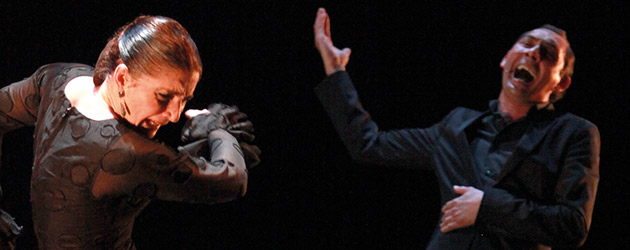Text: Estela Zatania
Photos: Ana Palma
18thIFESTIVAL DE JEREZ
Comp. Flamenca Alicia Márquez & Ramón Martínez
«Los Hilos del Tiempo»
Juan Villar, Felipe Scapachini
4th March 2014. Jerez de la Frontera
Special 18th Festival de Jerez – All the information
COMP. FLAMENCA ALICIA MÁRQUEZ & RAMÓN MARTÍNEZ
“LOS HILOS DEL TIEMPO”
Teatro Villamarta, 9:00pm
The work “Los Hilos del Tiempo” by the company of Alicia Márquez and Ramón Martínez, begins with the projection of dream-like images that suggest the passage of time. The tic-toc of a clock is heard for those people (such as myself) who don’t always catch these philosophical messages, and the two dancers do footwork to that sound, without music or voice, for some ten minutes.
The artists themselves describe the work at “traditional-conceptual”, which shows their desire to do something contemporary, without abandoning the classic forms. This is not easy territory to locate, and as has happened in other attempts by other artists, what we mostly see is a trading-off or alternation of traditional and avant-garde numbers.
When the two singers, Pepe de Pura and Antonio Núñez “El Pulga” arrive on stage, with the guitars of Juan Requena, Oscar Lagos and Paco Vega, everything comes to life and suddenly it’s bulerías. Next, a barely audible off-stage voice (it wasn’t me, everyone around me was asking “what’s he’s saying?), a naked lightbulb, a seated female dancer and a very dense darkness indicate we have returned to the conceptual world.
Ramón Martínez dances soleá without generating much excitement. To make the transition to siguiriyas, Pulga sings trilla songs, and Alicia takes the stage with her black bata de cola, and black shawl, making it very difficult to see her movements against the black backdrop. Things are still not getting off the ground. Sometimes, with the pretext of “escuela sevillana”, based on elegance and a certain minimalism, dancers forget to let their emotions show. The more serene the delivery, the greater the intensity that must be insinuated, or you just end up with something pretty but vacant.
The following number, which appears on the program simply as “bulerías”, is a delightful creation. Here we do see the possibilities of a new take on classic elements. Ramón has a steamer trunk. That’s the initial focus. The dancer speaks, and once again muddy sound keeps you from catching much of what he says. Random footwork without music incorporates kicks to the trunk which is amplified, then an entertaining segment in which the dancer’s hat becomes a second “person” and the whole thing progressively starts coming together. Adequate lighting now allows you to see the gestures and movements, and the number ends up being a kind of bulerías suite, possibly the best thing in the show (it feels like an affectation to call this a “work”).
The two dancers team up to interpret a contemporary tango song, and our eyes are grateful when the couple comes out dressed in gleaming white to end with cantiñas.
JUAN VILLAR, FELIPE SCAPACHINI
Palacio Villavicencio, 7:00pm
It’s a sad sign of the flamenco times when a magnificent veteran, one of the last great stars of his generation, a tremendous singer like Juan Villar, ends up doing a recital in the small venue of the Palacio Villavicencio normally reserved for beginners, unknowns and other interpreters of limited interest. And in a shared recital at that. He came with another respected veteran, less-known but worthy of recognition: Felipe Scapachini, and both were accompanied by Jerez guitarist Niño Jero, Periquín.
These are the two authoritative voices left in Cádiz flamenco singing. They offered a friendly facing-off, taking turns, cante by cante and being mutually supportive. Villar, por soleá, por fandangos, in good voice, with the phrasing and shading that only comes with maturity, ending with his famous bulerías and that knack he has for making everything sound flamenco…”Eres bella entre las bellas, pero por dentro vacía…” and “Todo acabó”, his trademark verses. At this stage, everything flows easily and it’s all flavor.
Scapachini defended his terrain with absolute dignity with “tientos de Cádiz” as he said, alegrías with that certain something only the people of Cádiz manage, a string of tangos accompanied in E-position and malagueña.
Juan Villar & Felipe Scapachini
Alicia Márquez – Ramón Martínez
